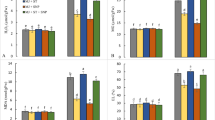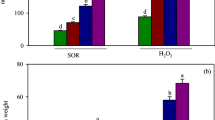Abstract
Dimethylthiourea is an important plant growth regulator that mediates various physiological and metabolic processes of the plants. In the present study, role of dimethylthiourea in conferring arsenic stress tolerance to Cajanus cajan L. was investigated. Exposure to arsenic resulted in oxidative damage as evidenced by decreased germination percentage, radicle length, biomass accumulation, membrane stability index, protein, glyoxalase I and II, and antioxidants, together with enhanced cell death, reactive oxygen species, lipid peroxidation and activity of lipoxygenase in C. cajan L. However, exogenous application of dimethylthiourea along with arsenic decreased the reactive oxygen species and lipoxygenase activity, while increased the membrane stability index and antioxidants activities. Moreover, dimethylthiourea also up-regulated the glyoxalase (I and II) activity and the gene expression of antioxidants under arsenic stress. Also, dimethylthiourea application reduced the arsenic content than that measured in arsenic alone treated samples. Interestingly, treatment of dimethylthiourea uplifted the contents of ascorbic acid and glutathione, together with proline via up-regulating the activity and gene expression of pyrroline-5-carboxylate synthetase, one of the chief enzymes of its biosynthetic pathway. Enlisted findings suggested that dimethylthiourea can improve plant resistance to arsenic toxicity by regulating the gene expression of antioxidants and proline biosynthesizing enzymes, thereby reducing reactive oxygen species, lipid peroxidation and arsenic accumulation.





Similar content being viewed by others
References
Abbas G, Murtaza B, Bibi I, Shahid M, Niazi NK, Khan MI, Amjad M, Hussain M, Natasha (2018) Arsenic uptake, toxicity, detoxification, and speciation in plants: physiological, biochemical, and molecular aspects. Int J Environ Res Public Health 15:59–103
Anjum SA, Tanveer M, Hussain S, Shahzad B, Ashraf U, Fahad S, Hassan W, Jan S, Khan I, Saleem MF, Bajwa AA, Wang L, Mahmood A, Samad RA, Tung SA (2016) Osmoregulation and antioxidant production in maize under combined cadmium and arsenic stress. Environ Sci Pollut Res 23:11864–11875
Bates LS, Waldren RP, Teare ID (1973) Rapid determination of free proline for water stress studies. Plant Soil 39:205–207
Bradford MM (1976) A rapid and sensitive method for the quantification of microgram quantities of protein utilizing the principle of protein-dye binding. Anal Biochem 72:248–254
Chance M, Maehly AC (1955) Assay of catalases and peroxidases. Methods Enzymol 2:764–817
Chandrakar V, Keshavkant S (2018) Nitric oxide and dimethylthiourea up-regulates pyrroline-5-carboxylate synthetase expression to improve arsenic tolerance in Glycine max L. Environ Prog Sustain Energy. https://doi.org/10.1002/ep.12978
Chandrakar V, Dubey A, Keshavkant S (2016) Modulation of antioxidant enzymes by salicylic acid in arsenic exposed Glycine max L. J Soil Sci Plant Nutr 16:662–676
Chandrakar V, Yadu B, Meena R, Dubey A, Keshavkant S (2017a) Arsenic-induced genotoxic responses and their amelioration by diphenylene iodonium, 24-epibrassinolide and proline in Glycine max L. Plant Physiol Biochem 112:74–86
Chandrakar V, Parkhey S, Dubey A, Keshavkant S (2017b) Modulation in arsenic induced lipid catabolism in Glycine Max using proline, 24-epibrassinolide and diphenylene iodonium. Biologia 72:292–299
Chandrakar V, Dubey A, Keshavkant S (2018) Modulation of arsenic-induced oxidative stress and protein metabolism by diphenyleneiodonium, 24-epibrassinolide and proline in Glycine max L. Acta Bot Croat 77:51–61
Farooq MA, Li L, Ali B, Gill RA, Wang J, Ali S, Gill MB, Zhou W (2015) Oxidative injury and antioxidant enzymes regulation in arsenic-exposed seedlings of four Brassica napus L. cultivars. Environ Sci Pollut Res 22:10699–10712
Garcia-Rios M, Fujita T, Larosa PC, Locyi RD, Clithero JM, Bressan RA, Csonka LN (1997) Cloning of a poly cistronic cDNA from tomato encoding γ-glutamyl kinase and γ-glutamylphosphate reductase. Proc Natl Acad Sci USA 94:8249–8254
Griffith OW (1980) Determination of glutathione and glutathione disulfide using glutathione reductase and 2-vinylpyridine. Anal Biochem 106:207–212
Hasanuzzaman M, Fujita M (2013) Exogenous sodium nitroprusside alleviates arsenic-induced oxidative stress in wheat (Triticum aestivum L.) seedlings by enhancing antioxidant defence and glyoxalase system. Ecotoxicology 22:584–596
Hodges DM, DeLong JM, Forney CF, Prange RK (1999) Improving the thiobarbituric acid-reactive-substances assay for estimating lipid peroxidation in plant tissues containing anthocyanin and other interfering compounds. Planta 207:604–611
Hossain MA, Fujita M (2009) Purification of glyoxalase I from onion bulbs and molecular cloning of its cDNA. Biosci Biotechnol Biochem 73:2007–2013
Jiang M, Zhang J (2002) Water stress-induced abscisic acid accumulation triggers the increased generation of reactive oxygen species and up-regulates the activities of antioxidant enzymes in maize leaves. J Exp Bot 53:2401–2410
Kumari A, Pandey N, Pandey-Rai S (2018) Exogenous salicylic acid-mediated modulation of arsenic stress tolerance with enhanced accumulation of secondary metabolites and improved size of glandular trichomes in Artemisia annua L. Protoplasma 255:139–152
Li CX, Feng SL, Shao Y, Jiang LN, Lu XY, Hou XL (2007) Effects of arsenic on seed germination and physiological activities of wheat seedlings. J Environ Sci 19:725–732
Livak KJ, Schmittgen TD (2001) Analysis of relative gene expression data using real-time quantitative PCR and the 2-δCT method. Methods 25:402–408
Mallick S, Kumar N, Singh AP, Sinam G, Yadav RN, Sinha S (2013) Role of sulfate in detoxification of arsenate-induced toxicity in Zea mays L. (SRHM 445): nutrient status and antioxidants. J Plant Int 8:140–154
Marklund S, Marklund G (1974) Involvement of the superoxide anion radical in the autoxidation of pyrogallol and a convenient assay for superoxide dismutase. Eur J Biochem 47:469–474
Mukherjee SP, Choudhuri MA (1983) Implications of water stress-induced changes in the levels of endogenous ascorbic acid and hydrogen peroxide in Vigna seedlings. Physiol Plant 58:166–170
Nair PMG, Chung IM (2015) Physiological and molecular level studies on the toxicity of silver nanoparticles in germinating seedlings of mung bean (Vigna radiata L.). Acta Physiol Plant 37:1–11
Panda SK, Matsumoto H (2010) Changes in antioxidant gene expression and induction of oxidative stress in pea (Pisum sativum L.) under Al stress. Biometals 23:753–762
Principato GB, Rosi G, Talesa V, Govannini E, Uolila L (1987) Purification and characterization of two forms of glyoxalase II from rat liver and brain of Wistar rats. Biochim Biophys Acta 911:349–355
Sangeetha P, Das VN, Koratkar R, Suryaprabha P (1990) Increase in free radical generation and lipid peroxidation following chemotherapy in patients with cancer. Free Radic Biol Med 8:15–19
Sengupta D, Guha A, Reddy AR (2013) Interdependence of plant water status with photosynthetic performance and root defense responses in Vigna radiata (L.) Wilczek under progressive drought stress and recovery. J Photochem Photobiol 127:170–181
Srivastava AK, Sablok G, Hackenberg M, Deshpande U, Suprasanna P (2017) Thiourea priming enhances salt tolerance through co-ordinated regulation of microRNAs and hormones in Brassica juncea. Sci Rep 7:45490
Talukdar D (2014) Arsenic-induced oxidative stress and its reversal by thiourea in mung bean (Vigna radiata L.) wilczek genotype. Cent Eur J Exp Biol 3:13–18
Talukdar D (2016) Exogenous thiourea modulates antioxidants defense and glyoxalase systems in lentil genotypes under arsenic stress. J Plant Stress Physiol 2:9–21
Velikova V, Yordanov I, Edreva A (2000) Oxidative stress and some antioxidant systems in acid rain- treated bean plants. Plant Sci 151:59–66
Woodbury W, Spencer AK, Stahmann MA (1971) An improved procedure using ferricyanide for detecting catalase isozymes. Anal Biochem 44:301–305
Xalxo R, Keshavkant S (2017) Acid rain-induced oxidative stress regulated metabolic interventions and their amelioration mechanisms in plants. Biologia 72:1387–1393
Xalxo R, Yadu B, Chakraborty P, Chandrakar V, Keshavakant S (2017) Modulation of nickel toxicity by glycinebetaine and aspirin in Pennisetum typhoideum. Acta Biol Szeged 61:163–171
Yadu B, Chandrakar V, Meena RK, Keshavkant S (2017a) Glycinebetaine reduces oxidative injury and enhances fluoride stress tolerance via improving antioxidant enzymes, proline and genomic template stability in Cajanus cajan L. S Afr J Bot 111:68–75
Yadu S, Dewangan TL, Chandrakar V, Keshavkant S (2017b) Imperative roles of salicylic acid and nitric oxide in improving salinity tolerance in Pisum sativum L. Physiol Mol Biol Plants 23:43–58
Yadu B, Chandrakar V, Meena RK, Dubey A, Poddar A, Keshavkant S (2018a) Spermidine and melatonin attenuate fluoride toxicity by regulating gene expression of antioxidants in Cajanus cajan L. J Plant Growth Regul. https://doi.org/10.1007/s00344-018-9786-y
Yadu B, Chandrakar V, Korram J, Satnami ML, Kumar M, Keshavkant S (2018b) Silver nanoparticle modulates gene expressions, glyoxalase system and oxidative stress markers in fluoride stressed Cajanus cajan L. J Hazard Mater 353:44–52
Zhang A, Jiang M, Zhang J, Tan M, Hu X (2006) Mitogen-activated protein kinase is involved in abscisic acid-induced antioxidant defense and acts downstream of reactive oxygen species production in leaves of maize plants. Plant Physiol 141:475–487
Acknowledgements
The authors would also like to thank Defense Research and Development Organization, New Delhi (DRDE/TC/05414/Proj/TASK-220/16 Dated June 27, 2016) and Department of Science and Technology, New Delhi (No. DST/INSPIRE Fellowship/2013/791, dated 23.01.2013) for providing research facilities for this study. Authors are also grateful to Department of Science and Technology, New Delhi, for financial support through DST-FIST scheme (Sanction No. 2384/IFD/2014-15, dated 31.07.2014) sanctioned to the School of Studies in Biotechnology.
Author information
Authors and Affiliations
Corresponding author
Additional information
Editorial responsbility: M. Abbaspour.
Rights and permissions
About this article
Cite this article
Yadu, B., Chandrakar, V., Tamboli, R. et al. Dimethylthiourea antagonizes oxidative responses by up-regulating expressions of pyrroline-5-carboxylate synthetase and antioxidant genes under arsenic stress. Int. J. Environ. Sci. Technol. 16, 8401–8410 (2019). https://doi.org/10.1007/s13762-019-02234-5
Received:
Revised:
Accepted:
Published:
Issue Date:
DOI: https://doi.org/10.1007/s13762-019-02234-5




